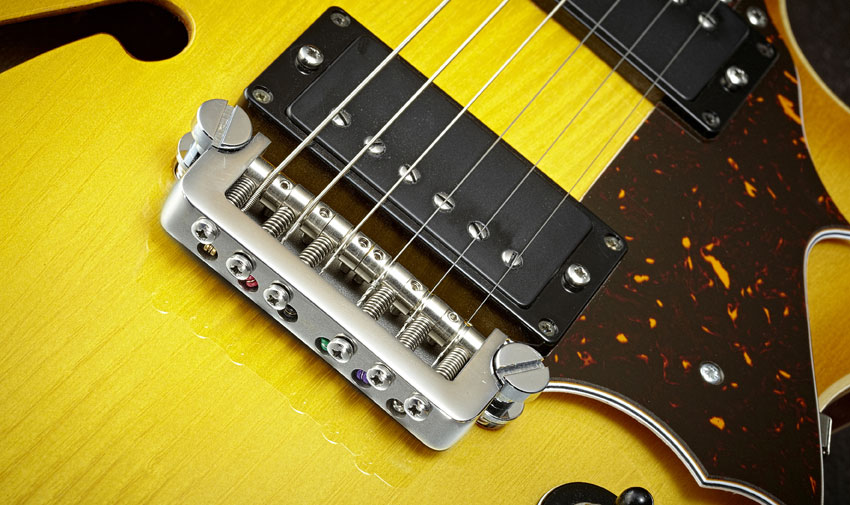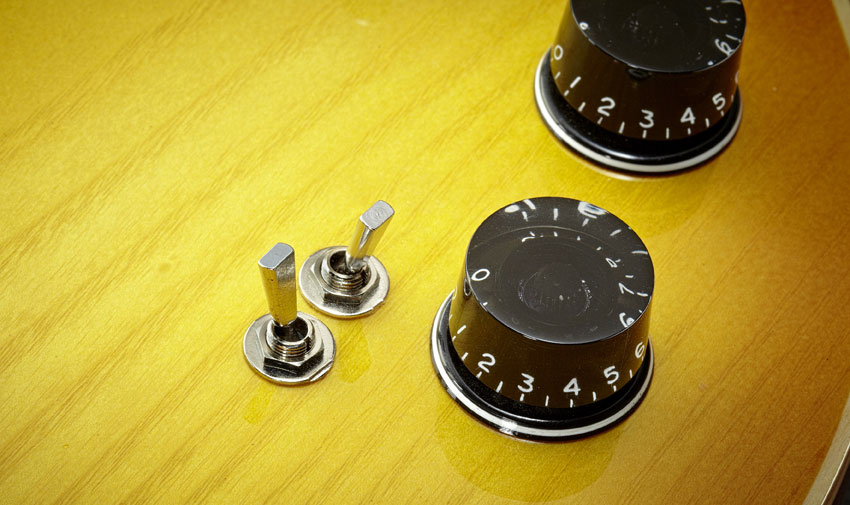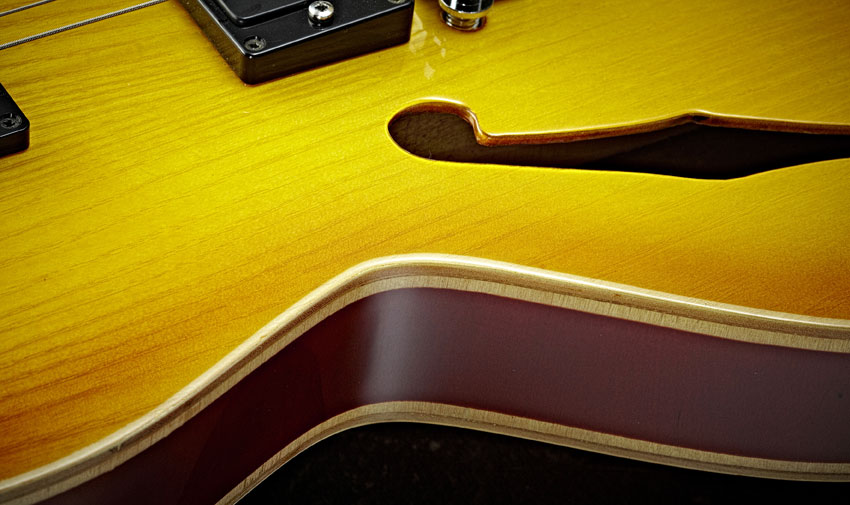MusicRadar Verdict
A sound-laden semi for players who know how to handle their guitars. The best-ever GSG guitar.
Pros
- +
Handmade in the UK. Idiosyncratic design. Volumax.
Cons
- -
We could live without the Blacklab overdrive.
MusicRadar's got your back

Gordon-Smith Ghostrider

Bridge

FX switches

Body

Pickups
Hugely inventive in a self-proclaimed 'Heath Robinson' fashion, Gordon- Smith's main man, John Smith, has created an idiosyncratic way of building his company's guitars. You won't find any CNC milling machines in the vicinity, and the majority - if not all - of the jigs, templates and fixtures have been conceived, designed and handmade by John.
"Add in the self-designed pickups, bridge and clever circuitry here and you have a uniquely different instrument"
There's the circular saw-assisted neck shaping machine that cuts two necks simultaneously, the 'secret' way in which John inserts his truss rods, and the presence of unusual woods such as poplar instead of mahogany or maple for some of his instruments' necks. Add in the self-designed pickups, bridge and clever circuitry here and you have a uniquely different instrument.
Fuelled by the strongest tea this writer has ever tasted, the guitars are made, as they have been for many years, by John, his wife Linda, and Chris Smith (no relation!) from their base just outside of Manchester.
Collaborative design
John's latest creation is the Ghostrider, a wonderfully inventive, oh-so-retro model. "It's all our years poured into one bottle," says John. The idea came from GSG customer Manfred Tripke who asked John for a centre-block semi, bigger than a Les Paul but smaller than an ES-335.
The finished guitar incorporates a pine centre block, and its back, sides and top are a nicely grained three-piece ash-faced laminate. It doesn't have the pressed contours of an ES-335, but it's far from flat, especially its back. It's tidily finished, too, with a Melamine honey centred top 'burst and a timeless vibe from the caramel back, sides and neck.
With a pretty classic deep C profile neck, the nut width is a little greater than most mainstream electrics and that highly polished brass nut is height adjustable, if necessary. The Gibson-esque head is back-angled and adorned with a simple logo and what looks like a truss rod cover.
It isn't: access to the rod is at the body end of the neck under a small cover plate. The 'board is tidy enough, but we found the frets a little low - the guitar seems to want a taller fret, especially if you're a string bender.
Want all the hottest music and gear news, reviews, deals, features and more, direct to your inbox? Sign up here.
Along with the GSG pickups and adjustable hardtail bridge, the two rotary controls and three-way toggle pickup switch are all front-mounted - there's no rear cavity cover. But it's those two-way mini switches that reveal the guitar's secret weapons: the Volumax volume booster and Blacklab overdrive simulator.
Feel and sounds
At the top of the tone control's travel (like Fender's No Load tone control, which it pre- dates), the pot is effectively bypassed resulting in maximum treble. That can sound a little spiky, especially on the coil-splits and the bridge humbucker. But wind down the tone control and things smooth out considerably.
"Pushing the upper switch down introduces the Volumax - there's a noticeable increase in output, thickening the mids and lower mids"
With both of the mini-switches pointing up towards you, neither has an effect. Pushing the upper switch down introduces the Volumax - there's a noticeable increase in output, thickening the mids and lower mids.
Push the lower switch down for the 'overdrive' effect; it sounds more like a fuzztone with a clean amp and squashes the dynamics a little. Both have more effect on the neck pickup. Switching to a crunch channel, the Blacklab gets a little lost, while winding up the tone control adds some necessary edge. Likewise, that volume boost can sound a little too round-nosed.
Generally, the GSG humbuckers sound a little compressed to our ears and we can't help thinking 0.011s would suit if you're after more dynamic chunk. Conversely, starting with a clean amp, we find ourselves switching between bright cleans that can easily be tamed with that tone control; if you need a little more thickness the Volumax supplies it.
The neck pickup adds plenty of depth and smoothness, too. Need more bite? Wind up the tone. There are some excellent jazzier 'semi' voices and the construction definitely adds resonance.
"Kick in your solo boost and that neck pickup is very vocal, with musical feedback close at hand"
With more gained sounds there's a good ring to the guitar for janglier, crunchy voices. Kick in your solo boost and that neck pickup is very vocal, with musical feedback close at hand. As supplied, though, this isn't the best string- bender - more Britpop than Brit blues boom - but for a rhythm player, especially those who use a wide range of textures, the Ghostrider makes a lot of sense.
"Our guitars are made for people who know how to use them," says Smith. "Players who don't use their volume and tone controls won't get the best out of 'em."
If you do play in this way, the Ghostrider has sounds aplenty and stylistic application that ranges from jazz through 60s jangle, and classic rock to modern indie crunch textures.
This is the finest of quite a few Gordon-Smith guitars this writer has played. Construction is tidy and the range of sounds spectacular. The Volumax is a great asset, the Blacklab... Well, we'd rather have our effects on the floor. Still, the flexible options of a GSG build mean that's no issue, neither are those slightly low frets.
Handmade, custom-order UK-made guitars rarely come close to this price, either. It's oddly compelling, and for the open-minded player, this is an essential guitar to track down.
Dave Burrluck is one of the world’s most experienced guitar journalists, who started writing back in the '80s for International Musician and Recording World, co-founded The Guitar Magazine and has been the Gear Reviews Editor of Guitarist magazine for the past two decades. Along the way, Dave has been the sole author of The PRS Guitar Book and The Player's Guide to Guitar Maintenance as well as contributing to numerous other books on the electric guitar. Dave is an active gigging and recording musician and still finds time to make, repair and mod guitars, not least for Guitarist’s The Mod Squad.
